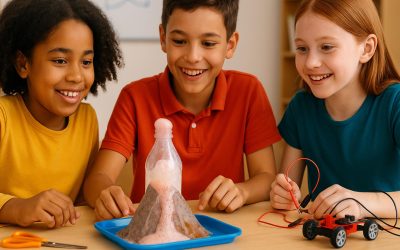Toys that simply talk are passé—today’s multilingual storytelling puppets actively engage children in bilingual play. These plush characters narrate stories in two languages—switching between them mid-sentence—then prompt kids to repeat key phrases. Some models even adapt the storyline based on the child’s responses, reinforcing newly learned words in context. By blending tactile play with language immersion, these puppets support vocabulary acquisition, pronunciation practice, and cultural appreciation.
How They Work
- Dual-Language Narration: Stories are pre-recorded or generated in two languages (e.g., English/Spanish), alternating by sentence or paragraph.
- Interactive Prompts: At key vocabulary points, the puppet pauses and asks the child to repeat a word or phrase, using voice-recognition feedback.
- Adaptive Branching: Correct responses unlock new story branches or bonus mini-games that reinforce the vocabulary.
- Offline and Online Options: Some puppets store a fixed library; others connect to apps for downloadable new stories and languages.
Benefits for Bilingual Learning
- Contextual Vocabulary: Hearing words in story context aids retention over rote drills.
- Pronunciation Feedback: Voice recognition gently corrects pronunciation, boosting confidence.
- Cultural Context: Stories often include cultural notes, songs, or facts in both languages.
- Play-Based Engagement: Children learn through play, reducing the pressure of formal lessons.
Top Puppets to Explore
- PolyGlot Pals: Offers 20 bilingual stories and built-in mini-dictionary mode.
- BabelBuddy: Connects via Bluetooth to update languages and story packs through a companion app.
- StorySpeak Puppet: Uses AI TTS engines for dynamic story generation in any two supported languages.
Getting Started at Home
- Choose Two Target Languages: Start with your home language plus one new language.
- Integrate into Routine: Use puppet storytime as part of daily read-aloud rituals.
- Encourage Repetition: Praise every attempt; correct gently by modeling proper pronunciation.
- Mix with Real Books: Read bilingual picture books alongside puppet sessions to reinforce concepts.
Conclusion
Multilingual storytelling puppets merge the magic of puppetry with interactive language learning—offering a playful, context-rich pathway to bilingualism. As smart toys evolve, these puppets invite families to build language skills together, one story at a time.
Q&A Section
Q1: What ages benefit most from these puppets?
A1: Ideal for ages 3–8, when play and repetition drive foundational language acquisition.
Q2: Can we add our own stories?
A2: Some models support custom story uploads via companion apps, expanding content over time.
Sources:
Parenting Science: “Play-Based Language Acquisition”
EdSurge: “Tech Toys for Bilingual Learning”
Wired: “The Rise of Smart Storytelling Toys”








0 Comments